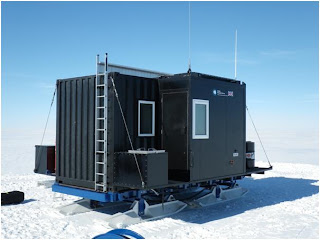
Peter 1 Island, only 800 people have stepped foot on it

Pack ice, small floes

the Ice shelf at cape flying fish

Barograph off the chart

DP screen, the green and purple circles are the positions from the seperate GPS'

The caboose on the ice for the first time

The fuel depot

iStar caboose

The sledges
The purpose of going to Cape flying fish was to input the iStar project. This was achieved, with the added bonus of being able to depot 160 drums of fuel. The significance of the fuel is that down here, the only way to transport it anywhere usually is by plane. To get one drum to where we made the depot a twin otter plane would burn 12. The lads are now making their way across of the ice, pulling their landtrain of fuel, food, accomodation, etc to the wintering site. They will then fly out leaving all the equipment for next year.
The comms have finally disappeared, hence the late updates. We are down to an analog system called the Iridium, MF/HF radio and if we were to get into difficulty we have a button which will send out a distress via the COMPASS-SARSAT satellite. We have morning and evening comms with both Rothera base and the James Clark Ross, it is used primarily to send our met reports.
Sunday 29/1/12. Noon Position 70° 17’ S 104° 21’W, approximately 9000 miles away from Northern Ireland. The weather has got fairly rough with F8-10 winds on the nose.
Compass variation is over 40°E.
The initial spot that was chosen by the land team was deemed unsuitable by us because there was 15miles of fast ice to break through in order to get there. The ice was fairly thick and a test session of 6 hours resulted in us making 0.5miles through it.
The next spot had us breaking a channel of over 2miles to get to the ice shelf, this was achieved in 12 hours then a day was spent alongside checking out the ice and ramp leading up to the shelf. It was deemed as a possibility but it would have required a lot of work to make it usable.
We steamed around to another spot because the ice had all been blown away, the weather picked up so the ship sat in DP waiting for the weather to improve. After a couple of days we finally got alongside, the lads got ashore with their ground penetrating radar and assessed the shelf. It turned out to be solid with no cravasses. They made a depot site 7km inland, now it was up to us to get everything there.
After 1.5 days of offloading, the ship was empty and everything was done. The 4 iStar lads are now making their way further inland and we are heading back to the Faulklands












































